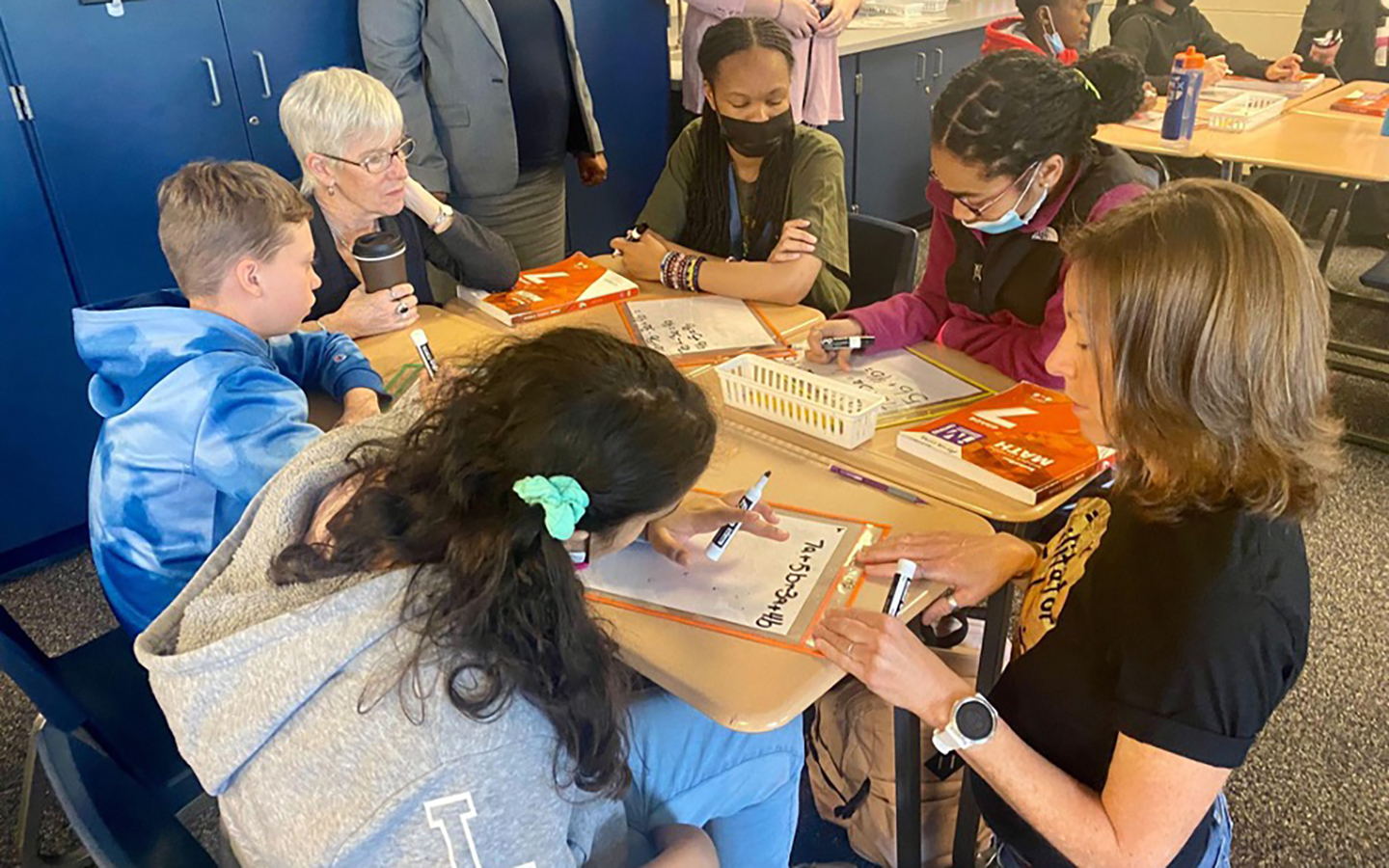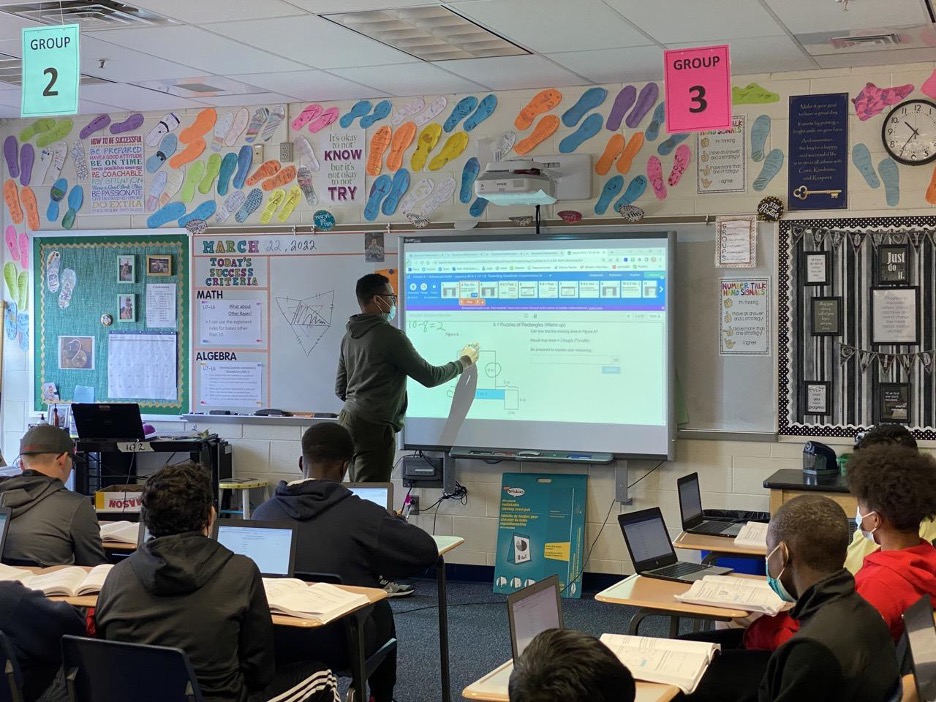With the World Shut Down, Bringing a Global Perspective to Math Class Changed Everything
How High Quality Curriculum Supported Mathematics Instruction Throughout the Pandemic

Get stories like these delivered straight to your inbox. Sign up for The 74 Newsletter
This is the first in a series of three pieces from a Knowledge Matters Campaign tour of school districts in Delaware highlighting their implementation of high-quality math curricula. Comprising the campaign’s first mathematics-focused tour, the story begins in Caesar Rodney School District in Wyoming, Delaware, which adopted Illustrative Mathematics in grades 6-8 four years ago. IM is a problem-based math curriculum that encourages student engagement. In this piece, Sarah Potter, Caesar Rodney’s 6-12 Math Specialist, explores how this high-quality curriculum helped support their district during COVID-19. Follow the rest of our series and previous curriculum case studies here.
During a visit by the Knowledge Matters Campaign to our district this spring, in answer to a question about what the panel of sixth- through eighth- grade students liked most about math, seventh grader Kacie said, “I like the problem-solving, and working as a team. And finding all the different solutions to one problem.”
Sixth grader Maya echoed, “Yeah, I like how there are many different ways to get your answer. Not all are the same.”
These students’ responses brought big smiles to the faces of all the administrators in the room. This is exactly why we had embarked on our journey to implement new high-quality instructional materials four years ago.
Caesar Rodney School District was the first school district established in Delaware in 1919, and is located in the heart of the state. We serve approximately 8,000 students. Over the past 10 years, our district has grown dramatically, necessitating the opening of several new schools.
While our district was expanding, we looked at student achievement data and made a collective decision that, “we can do better.” We realized our previous materials consisted of a lot of procedural fluency problems and lacked opportunities for students to engage in conceptual mathematics and problem solving.
Our journey began in 2018, with the adoption of Illustrative Mathematics in grades 6-8. We wanted to provide our students with a global mathematical perspective, bringing the real world into math class, and IM provided that. We were fortunate to have Southern Regional Education Board’s Debbie Robertson, a school improvement instructional coach, help lay the foundation for the instructional shifts called for in this new curriculum.
Our team was excited when the Knowledge Matters Campaign asked to visit us, to see inside middle school math classrooms. To the casual observer, our classrooms probably looked a lot like they had in pre-COVID times — but, in reality, much had changed.

Throughout COVID — during school closures and hybrid learning — our middle school teachers stayed the course with their new IM curriculum. IM provided us with instructional videos that teachers and students could use to support their virtual instruction, and provided “Adaptation Packs,” which consisted of adjusted units and lessons that supported our planning in the face of lost time due to COVID closures. They provided guidance on how to adjust instruction if students weren’t “getting it.”
In short, we had a curriculum partner supporting us in ways we never could have provided to each other, given everything else on our plates. As a result, not only did our teachers advance their understanding of the curriculum during those early days of the pandemic, our middle school iReady data showed no “summer slide” at the start of the 2020-21 school year.
Based on this experience, and even though a lot of people thought we were crazy, in the fall of 2020 (a hybrid year for us), we decided to pilot IM at the high school level for Algebra 1, Geometry and Algebra 2. We were awarded a Reimagining Professional Learning Grant from the Delaware Department of Education. Faith Muirhead, associate director of mathematics for the University of Delaware’s Professional Development Center for Educators, kicked off a two-year journey with our high school math teachers on learning how to effectively implement a problem-based curriculum with our students. The grant allowed teachers to spend more time participating in tailored professional learning sessions, which allowed them to learn more deeply about the paradigm shifts and instructional decisions called for in the curriculum.
“Students enter at different places in a problem,” Fifer Middle School Principal Kim Corbeil said. “It’s been really interesting to hear them say, ‘This is what I did.’ ”
Like the other high-quality mathematics curricula that were written in the wake of the Common Core State Standards, IM asks students to learn differently — to dialogue about mathematics, to engage with peers in problem solving, and to try multiple strategies for solving a problem. This is not the way most teachers were taught to teach mathematics.
“If I would be stuck on a problem, I’ll go to my friend who can show me a different strategy that I have never done before,” sixth-grade student Faith said. “Going to the teacher might get the same strategy I had already been trying that has me stuck.”
Providing an environment for this kind of learning represents a big change. Our high school teachers, in particular, previously used a completely procedural set of traditional materials. But, a strange thing happened in the fall of 2020 when we did this crazy thing of piloting HQIM during hybrid schooling: teachers found their students were more interested in learning mathematics than ever before, due to the problem-based nature of the curriculum.
We administered check-ins twice a year that revealed that students preferred learning math in a problem-based environment over a traditional approach — that they felt more confident, comfortable and excited about learning mathematics. (High School is now at the end of a two-year pilot and will vote on adoption this May.)
Returning from full hybrid learning this past year has been difficult, and we have found that the social-emotional needs of our middle school students, in particular, are great. Many of our eighth graders haven’t had to dialogue with classmates face-to-face throughout their entire middle school experience.
But despite the challenges, our K-12 math teachers are reporting how grateful they are to have the IM curriculum in place, noting that the materials provide rich tasks that allow students to engage with others, come out of their shells, and explain their thinking and methodologies to other students. Kids are finally getting to be social again and play, which is the best way to learn math. IM — and the journey we took to make it the centerpiece of our mathematics instruction — provided the space and the opportunity for this to happen.
Get stories like these delivered straight to your inbox. Sign up for The 74 Newsletter

;)